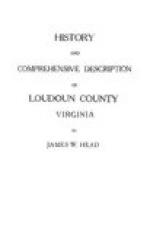Statistical.
AREA AND FARMING TABULATIONS.
The area of Loudoun County is variously reckoned at 460, 468, 495, 504, 510, 519, 520, and 525 square miles. The approximate accuracy of any single estimate in this confused assortment can not easily be determined, none, so far as is known, having been officially confirmed. Yardley Taylor, who, in 1853, made a most careful survey of the County, fixed its area at 525 square miles. By far the most trustworthy authority in this and certain other connections, his findings have been adopted with little uncertainty or hesitation.
Of this number, 207 square miles lie east of Catoctin Mountain and are of the upper secondary formation, while the remaining 318 square miles to the westward are of primitive formation.
The longest line across the County is 35 miles, and extends from the lower end of Lowe’s Island at the old mouth of Sugarland Run, to the summit of the Blue Ridge at Ashby’s Gap; the second longest, 34 miles, extends from the corner of Jefferson County, West Virginia, at the margin of the Potomac River below Harpers Ferry, to the corner of Fairfax County on Bull Run, within half a mile of Sudley Springs in Prince William County.
Within the limits of Loudoun are included 313,902[16] acres of the finest farm land to be found in any county of the State. The farms number 1,948, the average size being 162 acres. They are smallest in the northwestern portion of the county and of moderate size in the central portions, the largest occurring in the southern and eastern portions. In 1900, 1,754, or 90 per cent, were operated by white farmers, and 194, or 10 per cent, operated by colored farmers.
[Footnote 16: It will be understood that the total land in farms by no means equals the total area of the County.]
TABLE I.—Summary by Decades of the Improved and Unimproved Land in Farms, with per cent of Increase and Decrease.
-------+-----------------------------------+-----------
---------------------- | Acres of Land in Farms. | Per cent of Increase. |---------+-----------+-------------+---------+----------+--
---------- Census | | | | Total | Improved | Unimproved Year. | Total. | Improved. | Unimproved. | Land. | Land. | Land. -------+---------+-----------+-------------+---------+------
----+------------ 1900 | 313,902 | 251,874 | 62,028 | 6.4 | 6.9 | 4.8 1890 | 294,896 | 235,703 | 59,193 | [*]1.3 | 1.4 | [*]11. 1880 | 298,869 | 232,391 | 66,478 | 8.2 | 15.1 | [*]10.7 1870 | 276,291 | 201,888 | 74,403 | [*]6.7 | [*]8.3 | [*] 1.9 1860 | 296,142 | 220,266 | 75,876 | .5 | 5.7 | [*] 1.2 1850 | 294,675 | 208,454 | 86,221 | — | — | — -------+---------+-----------+-------------+---------+------
----+------------
[* — Decrease.]
The most striking fact to be noted concerning the reported farm areas is the comparatively great decrease in the decade 1860 to 1870. This was, of course, one of the disastrous effects of the Civil War, from which the South, in general, after more than forty-five years, has not yet fully recovered, as is shown by the fact that in some of the South Atlantic states the reported acreage of farm land in 1900 was less than it was in 1860.




